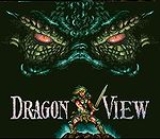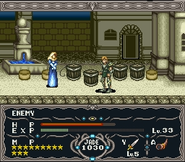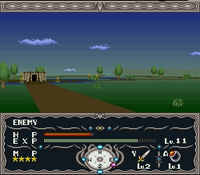
Dragon View
Encyclopedia
Dragon View, released in Japan as Super Drakkhen, and otherwise known as Drakkhen II, is a video game released for the Super Nintendo Entertainment System
in November 1994. It is meant to be a prequel to Drakkhen
. Although it bears little resemblance to its predecessor, it utilizes the same pseudo-3D
overworld system that the series is most famous for. Other features of Dragon View are its side-view Action
RPG
hybrid gameplay (used when exploring more detailed areas such as towns and dungeons), its well translated first person storyline, and its emphasis on player-driven "free" exploration.
Gameplay in this mode is reminiscent of Zelda II
for the Nintendo Entertainment System
. The character navigates various areas, exploring and fighting monsters in the traditional sense; an x plane (left and right motion) and y plane (jumping) control system. Movement through depth via z coordinates is also an important part of gameplay as it useful for evasion. While side-scrolling Action games in the past have used similar systems of movement (such as Final Fight
), Dragon View is unique amongst them for blending this style in a medieval setting and with RPG elements.
 Dragon View does not limit the player to moving in any one direction through the game; the player is allowed (and is sometimes required) to backtrack through any area or dungeon, all the way back to the game's starting point. It is this structure that often teases players with upgrades to equipment and special items that they cannot reach until later in the game, after they have unlocked certain capabilities, at which point they may return and claim the upgrade at their leisure.
Dragon View does not limit the player to moving in any one direction through the game; the player is allowed (and is sometimes required) to backtrack through any area or dungeon, all the way back to the game's starting point. It is this structure that often teases players with upgrades to equipment and special items that they cannot reach until later in the game, after they have unlocked certain capabilities, at which point they may return and claim the upgrade at their leisure.
Also present are the more traditional RPG growth elements. The character grows numerically stronger by gaining levels, as preset amounts of experience point
s are reached. The reward for a level gain is an increase in the offensive and defensive character stats, allowing the player to safely survive in more dangerous areas. Other stats, such as HP and MP
are increased when the player finds special items, often hidden inside areas of dungeons or the world map.
Many different types of such special items and upgrades are hidden throughout the world of Dragon View. Included are:
 The Drakkhen
The Drakkhen
series' most recognizable feature is its custom overworld engine. First used by the original Amiga
version of Drakkhen, it was later used in the PC
and SNES ports. The Dragon View version sports basic terrain shading and mountainlike "boundaries" that enclose areas of the continent. The day/night cycle however is no longer present.
While not "True 3D", the overworld
engine simulates depth on its own (without the aid of supplementary hardware such as the Super FX
chip) using sprite scaling and rudimentary rendering
. This system is able to run smoothly on standard SNES hardware because little more than half of the total screen area is ever in use. Since the top and bottom panels are completely static during overworld navigation, all hardware power is focused on rendering the first person view. Even so, framerates can suffer as many sprites are sometimes present on a single screen.
Super Nintendo Entertainment System
The Super Nintendo Entertainment System is a 16-bit video game console that was released by Nintendo in North America, Europe, Australasia , and South America between 1990 and 1993. In Japan and Southeast Asia, the system is called the , or SFC for short...
in November 1994. It is meant to be a prequel to Drakkhen
Drakkhen
Drakkhen is a 3D computer role-playing game which was initially developed for the Amiga and Atari ST, and subsequently ported to several other platforms, including MS-DOS and the Super Nintendo Entertainment System....
. Although it bears little resemblance to its predecessor, it utilizes the same pseudo-3D
3D computer graphics
3D computer graphics are graphics that use a three-dimensional representation of geometric data that is stored in the computer for the purposes of performing calculations and rendering 2D images...
overworld system that the series is most famous for. Other features of Dragon View are its side-view Action
Action game
Action game is a video game genre that emphasizes physical challenges, including hand–eye coordination and reaction-time. The genre includes diverse subgenres such as fighting games, shooter games, and platform games, which are widely considered the most important action games, though some...
RPG
Role-playing game
A role-playing game is a game in which players assume the roles of characters in a fictional setting. Players take responsibility for acting out these roles within a narrative, either through literal acting, or through a process of structured decision-making or character development...
hybrid gameplay (used when exploring more detailed areas such as towns and dungeons), its well translated first person storyline, and its emphasis on player-driven "free" exploration.
Gameplay
Most of the gameplay in Dragon View takes place through a side-view Action RPG hybrid system. Action occurs on a widescreen display, with a large panel displaying character and enemy information taking up the lower part of the screen. A decorative bar at the top of the screen provides a buffer and helps to present the game in a cinematic light.Gameplay in this mode is reminiscent of Zelda II
Zelda II: The Adventure of Link
Zelda II: The Adventure of Link, released as in Japan and often mistakenly called The Adventures of Link, is an action role-playing video game with platforming elements. The second installment in The Legend of Zelda series, it was developed and published by Nintendo for the Nintendo Entertainment...
for the Nintendo Entertainment System
Nintendo Entertainment System
The Nintendo Entertainment System is an 8-bit video game console that was released by Nintendo in North America during 1985, in Europe during 1986 and Australia in 1987...
. The character navigates various areas, exploring and fighting monsters in the traditional sense; an x plane (left and right motion) and y plane (jumping) control system. Movement through depth via z coordinates is also an important part of gameplay as it useful for evasion. While side-scrolling Action games in the past have used similar systems of movement (such as Final Fight
Final Fight
is a side-scrolling beat-'em-up game originally released by Capcom as a coin-operated video game in . It was the seventh game released by Capcom for their CP System arcade game hardware...
), Dragon View is unique amongst them for blending this style in a medieval setting and with RPG elements.

Also present are the more traditional RPG growth elements. The character grows numerically stronger by gaining levels, as preset amounts of experience point
Experience point
An experience point is a unit of measurement used in many role-playing games and role-playing video games to quantify a player character's progression through the game...
s are reached. The reward for a level gain is an increase in the offensive and defensive character stats, allowing the player to safely survive in more dangerous areas. Other stats, such as HP and MP
Magic point
Magic points are units of magical power that are used in many role-playing, computer role-playing and similar games as an expendable resource that is needed to pay for magic spells and other abilities, such as special attacks...
are increased when the player finds special items, often hidden inside areas of dungeons or the world map.
Many different types of such special items and upgrades are hidden throughout the world of Dragon View. Included are:
- Heart containers that increase maximum Hit points
- MP stars that increase maximum Magic pointMagic pointMagic points are units of magical power that are used in many role-playing, computer role-playing and similar games as an expendable resource that is needed to pay for magic spells and other abilities, such as special attacks...
s - Upgrades for the player's sword
- Upgrades for the player's armor
- A boomerang-type weapon called the Hauza and its upgrades
- A bow
- Three elemental magic rings with two upgrades for each
- Advanced techniques for the sword and Hauza
- A special bag that allows extra carrying capacity
3D Overworld

Drakkhen
Drakkhen is a 3D computer role-playing game which was initially developed for the Amiga and Atari ST, and subsequently ported to several other platforms, including MS-DOS and the Super Nintendo Entertainment System....
series' most recognizable feature is its custom overworld engine. First used by the original Amiga
Amiga
The Amiga is a family of personal computers that was sold by Commodore in the 1980s and 1990s. The first model was launched in 1985 as a high-end home computer and became popular for its graphical, audio and multi-tasking abilities...
version of Drakkhen, it was later used in the PC
Personal computer
A personal computer is any general-purpose computer whose size, capabilities, and original sales price make it useful for individuals, and which is intended to be operated directly by an end-user with no intervening computer operator...
and SNES ports. The Dragon View version sports basic terrain shading and mountainlike "boundaries" that enclose areas of the continent. The day/night cycle however is no longer present.
While not "True 3D", the overworld
Overworld
An overworld is, in a broad sense, an area within a video game that interconnects all its levels or locations. They are mostly common in role-playing games, though this does not exclude other video game genres....
engine simulates depth on its own (without the aid of supplementary hardware such as the Super FX
Super FX
The Super FX is a coprocessor chip used in select Super Nintendo Entertainment System video game cartridges. This custom-made RISC processor was typically programmed to act like a graphics accelerator chip that would draw polygons to a frame buffer in the RAM that sat adjacent to it...
chip) using sprite scaling and rudimentary rendering
Rendering (computer graphics)
Rendering is the process of generating an image from a model , by means of computer programs. A scene file contains objects in a strictly defined language or data structure; it would contain geometry, viewpoint, texture, lighting, and shading information as a description of the virtual scene...
. This system is able to run smoothly on standard SNES hardware because little more than half of the total screen area is ever in use. Since the top and bottom panels are completely static during overworld navigation, all hardware power is focused on rendering the first person view. Even so, framerates can suffer as many sprites are sometimes present on a single screen.

